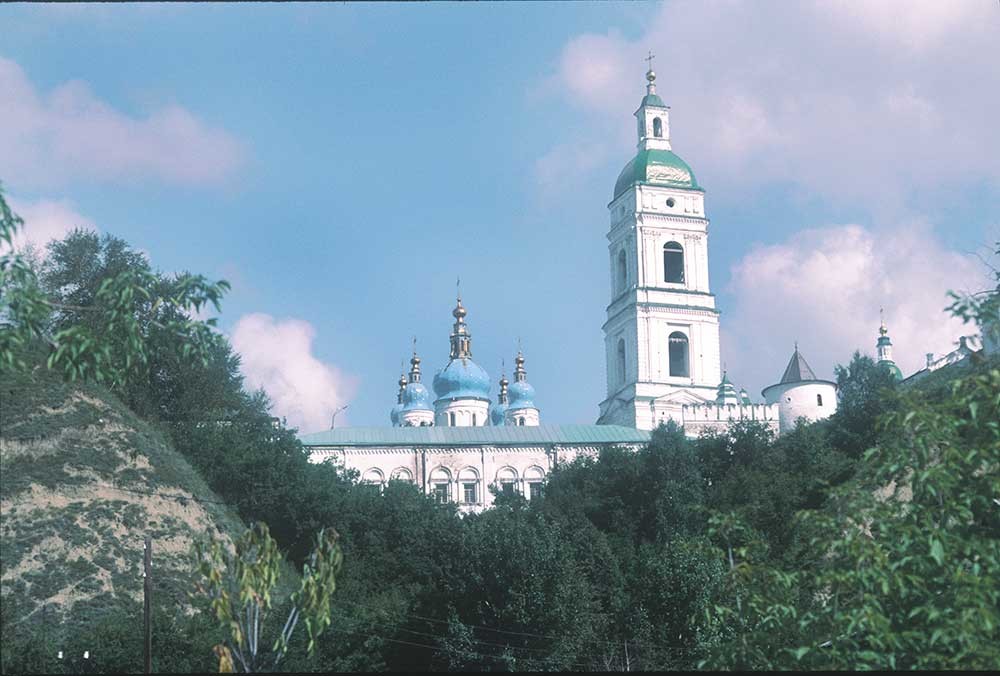
Tobolsk kremlin. View from Lower Town. Treasury ("Swedish Chambers"), cupolas of St. Sophia Cathedral&bell tower. August 31, 1999.
William BrumfieldAt the beginning of the 20th century, the Russian chemist and photographer Sergei Prokudin-Gorsky invented a complex process for vivid, detailed color photography. His vision of photography as a form of education and enlightenment was demonstrated with special clarity through his photographs of architectural monuments in the historic sites throughout the Russian heartland.
In June 1912, Prokudin-Gorsky ventured into western Siberia as part of a trip along the Kama-Tobolsk Waterway, a historic link between the European and Asian sides of the Ural Mountains. Traveling on the small paddlewheel steam cutter “Tyumen,” he photographed the town of Tyumen on the Tura River and arrived in Tobolsk, where he took several stunning panoramas. My photographs of the Tobolsk area were taken in the late summer of 19
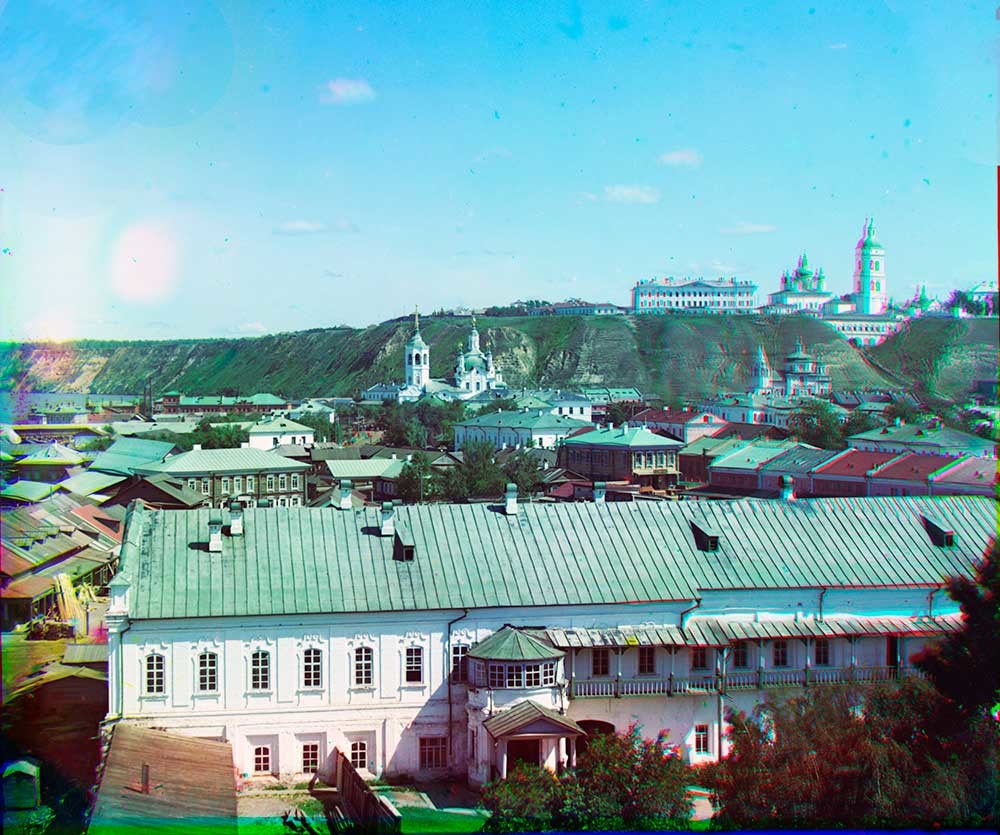
Tobolsk. View toward north from bell tower of Znamensky Monastery. Church of Sts. Zacharias&Elizabeth (left), Epiphany Church. Background: Tobolsk kremlin with Regional Administration, St. Sophia Cathedral, bell tower and Rentereya ("Swedish Chambers"). June 1912.
Sergei Prokudin-GorskyUntil the Soviet period, western Siberia was administered primarily from Tobolsk, whose citadel overlooked the high right bank of the Irtysh River, a tributary of the Ob River and a critical artery for Russian movement into Siberia. It was in this area of the Irtysh that a band of Cossacks, led by the legendary Yermak and supported by the Stroganovs, defeated the Tatar troops of Khan Kuchum in 1582. Boris Godunov — the power behind the Muscovite throne from 1586 until he became tsar himself in 1598 — understood the potential of Siberia, and launched a campaign to establish settlements. Tobolsk was founded in 1587 by the Cossack leader Daniel Chulkov at the confluence of the Tobol and Irtysh Rivers.
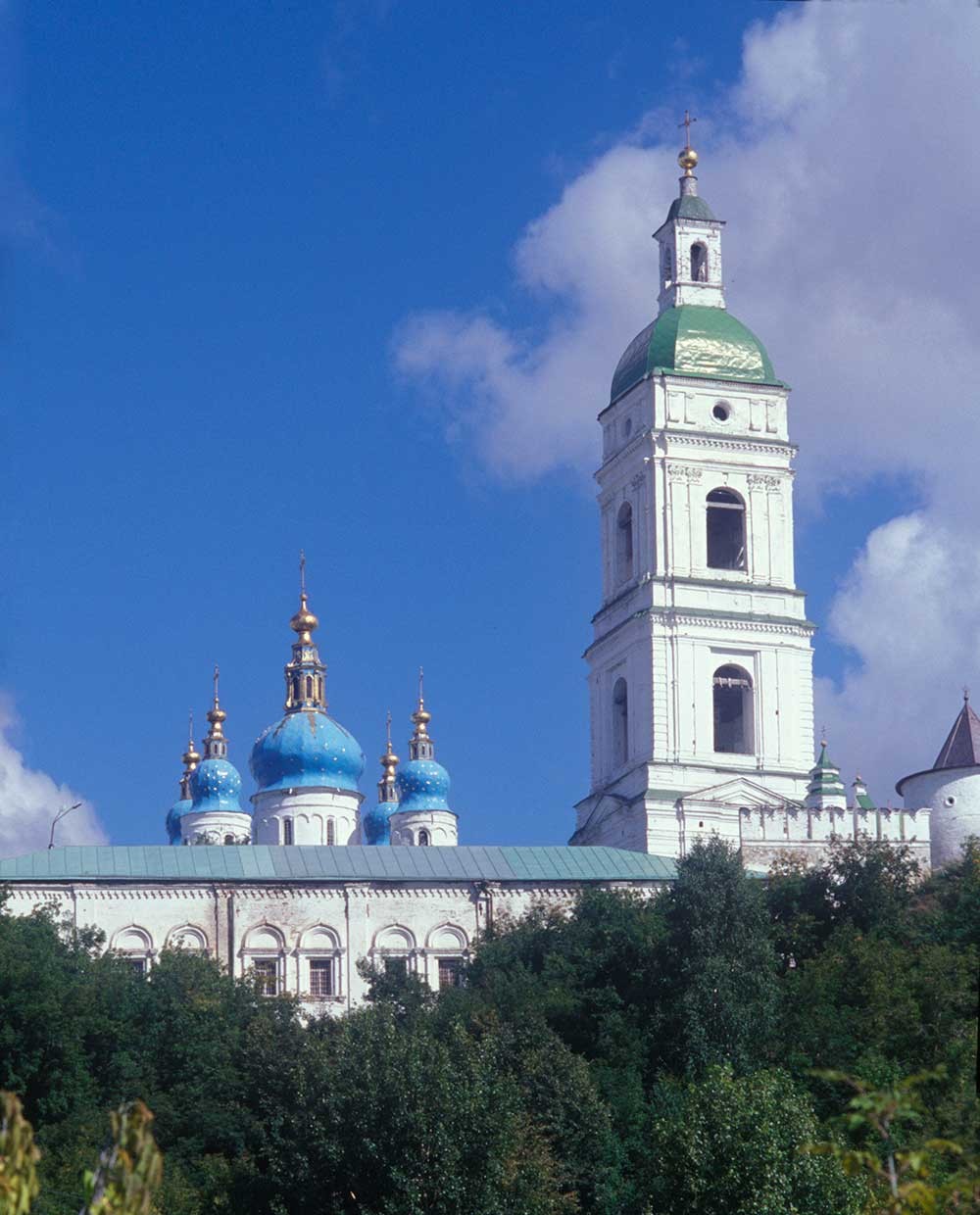
Tobolsk kremlin. South view. Treasury ("Swedish Chambers"), cupolas of St. Sophia Cathedral, bell tower. August 31, 1999.
William BrumfieldTobolsk is sharply divided by topography into two sections: upper and lower. The upper part — often referred to as the Tobolsk Kremlin — was reserved for institutions of power such as the territorial administration and the cathedral ensemble. The lower part contained the merchant district, the Tatar district
In the lower town, his prime vantage point was the Transfiguration Church bell tower (destroyed during the Soviet period) at the Znamensky Monastery. From there, he took a spectacular north view that encompassed the
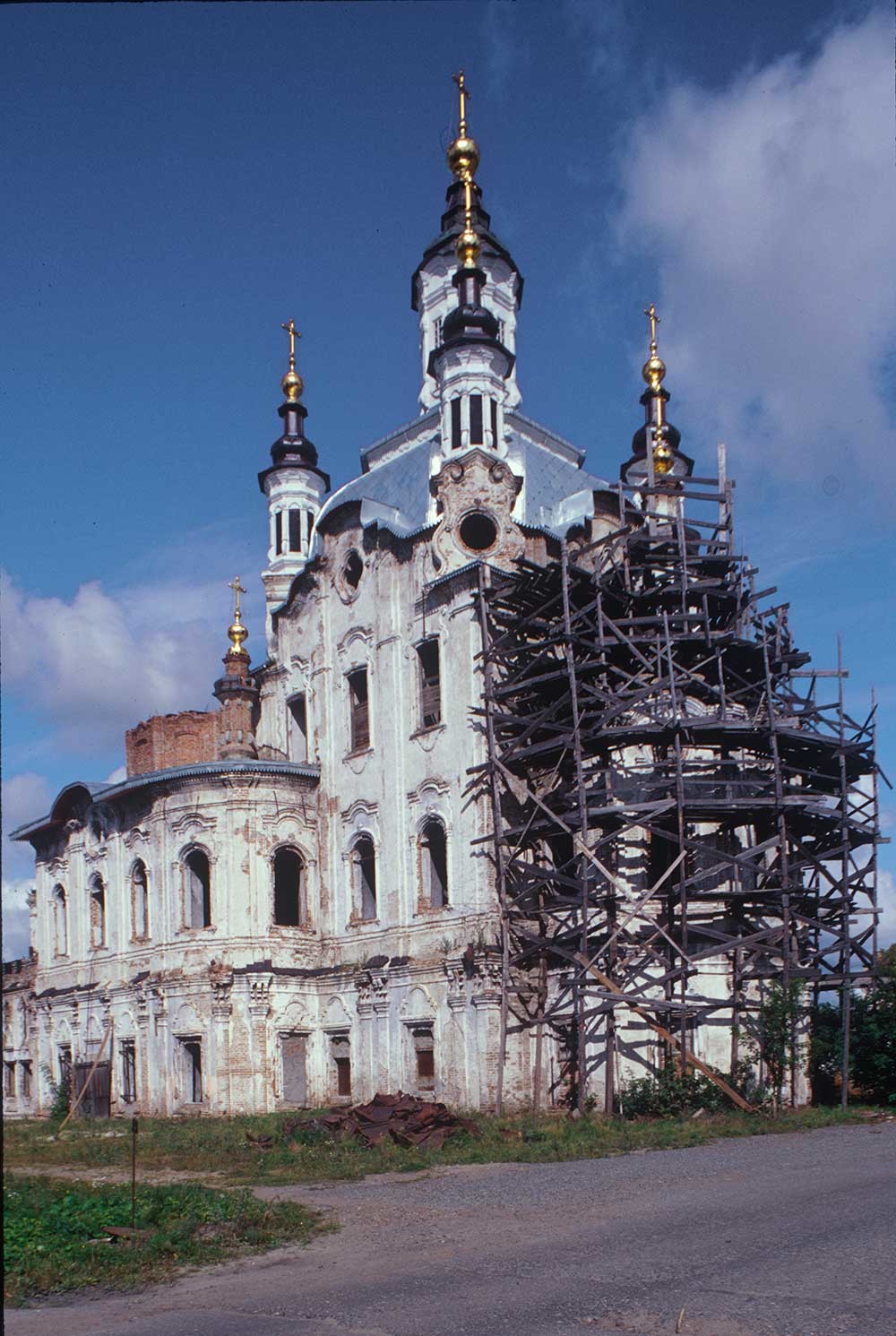
Church of Sts. Zacharias&Elizabeth, southeast view. August 31, 1999.
William BrumfieldVisible in the center
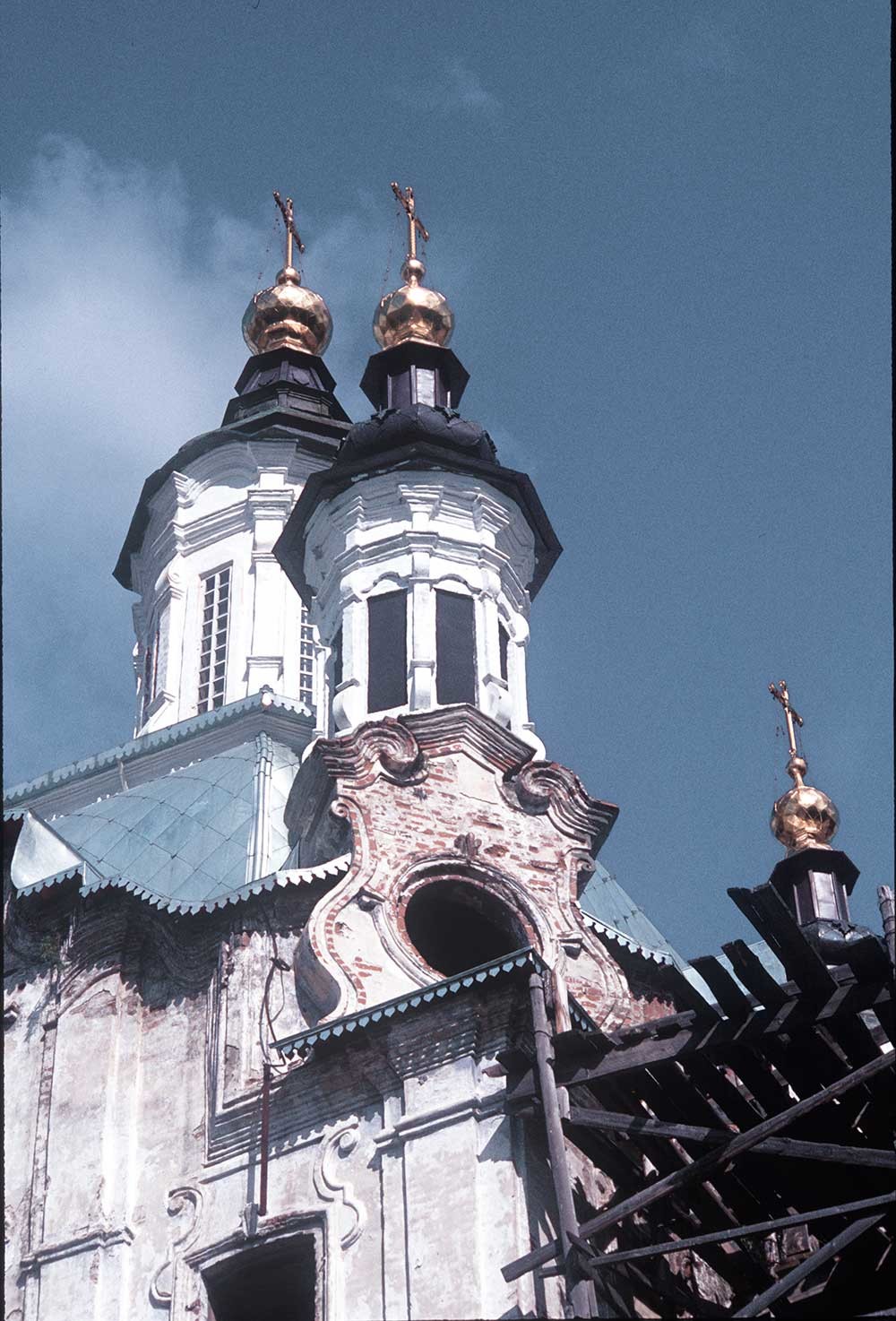
Church of Sts. Zacharias&Elizabeth. Decorative details on southeast corner. August 31, 1999.
William BrumfieldFires periodically consumed the wooden cathedral, and after a lightning strike in May 1677, Metropolitan Pavel, Prelate of Siberia, obtained support from
The vertical dominant in the Tobolsk

Tobolsk Lower Town. View south from kremlin bluff. From left: Church of Sts. Zacharias&Elizabeth, Znamensky Monastery & bell tower, Church of Elevation of the Cross, Irtysh River with docks. June 1912.
Sergei Prokudin-GorskyAlso visible in his photograph is the
Visible below the Sophia Cathedral in Lower Town is the Epiphany Church, closed in 1930 and razed in 1949. A somewhat better fate awaited its neighbor to the left, the ornate Church of Sts. Zacharias and Elizabeth, also
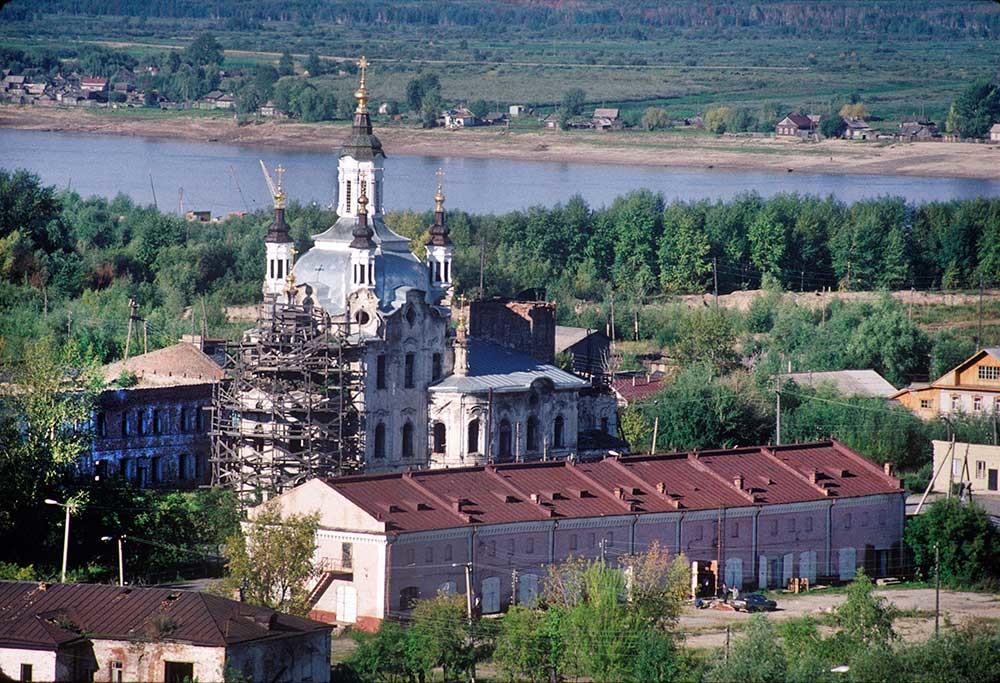
Church of Sts. Zacharias&Elizabeth. Northeast view from kremlin bluff. Background: Irtysh River. September 1, 1999.
William BrumfieldThe interior of the Church of Sts Zacharias and Elizabeth contained the most accomplished baroque icon screen in western Siberia, but it has not survived. In the 1930s, the interior was despoiled, and the bell tower and cupolas were demolished. Because parish needs are currently being met in the nearby Archangel Michael Church, the restoration of Sts Zacharias and Elizabeth has proceeded at a glacial pace, evident from the scaffolding in my 1999 photographs. The five cupolas were rebuilt in the late 1980s.
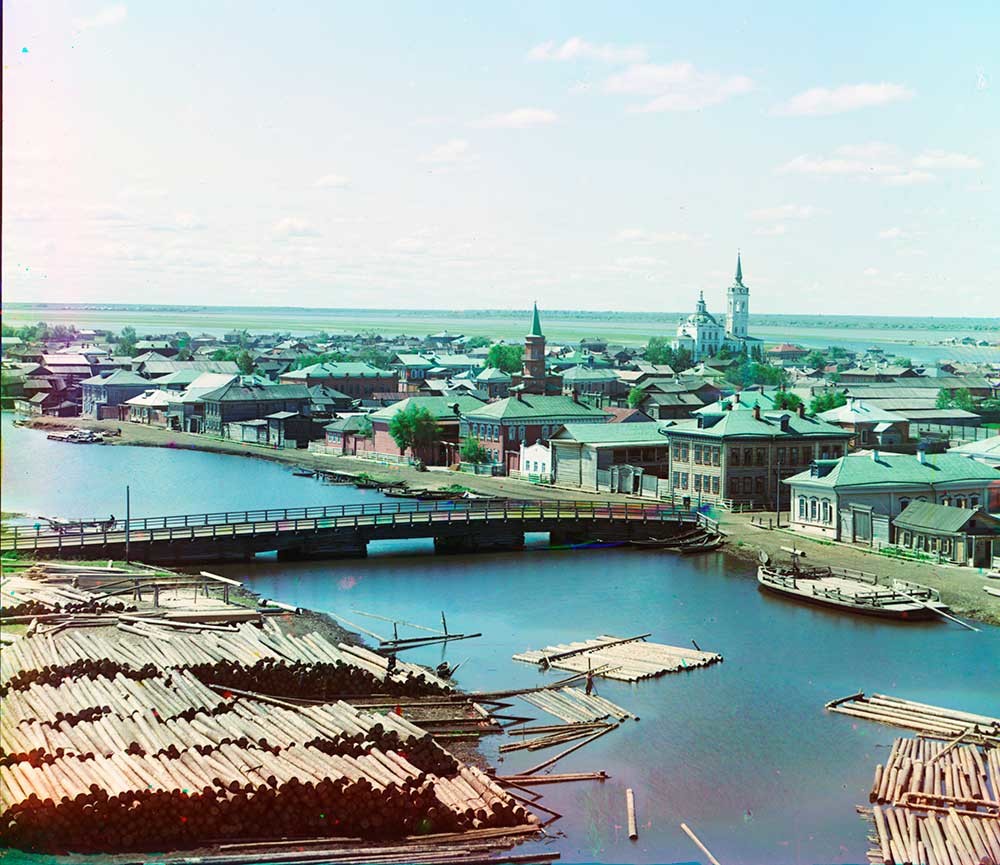
Tobolsk Lower Town. View southwest from bell tower of Znamensky Monastery. Beyond Abramovka River: Mosque minaret (center), Church of Elevation of the Cross with Irtysh in background. June 1912.
Sergei Prokudin-GorskyProkudin-Gorsky’s other view from the Znamensky Monastery bell tower looks southwest toward the Irtysh across the small Abramovka (or Monastyrka) River. Stacked with logs on the near bank, the river is lined with the houses of prosperous merchants in the Tatar-Bukhara District.
To the left is the minaret of the district's red brick mosque, built at the end of the 19th century to replace a wooden mosque. A mosque is thought to have existed on the site for centuries. The main patron was the merchant Tokhtasyn Aitmukhametov, who also supported a religious school, or madrasah, at the mosque. Closed in 1930, the mosque was returned to the local Muslim community in 1988.
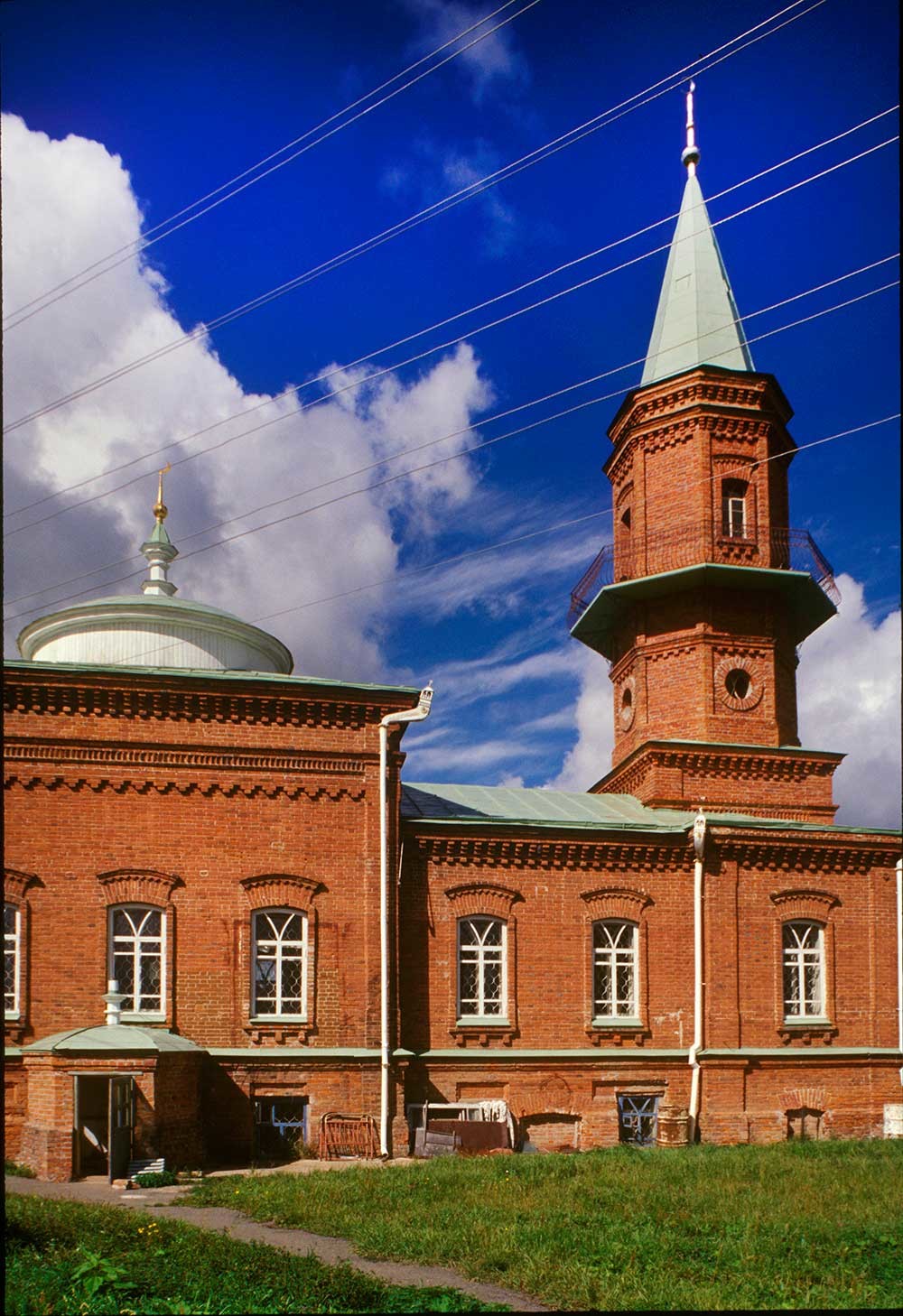
Tobolsk Mosque, south view. August 31, 1999.
William BrumfieldTo the right of the mosque is the Church of the Elevation of the Cross, the town's first masterpiece of late
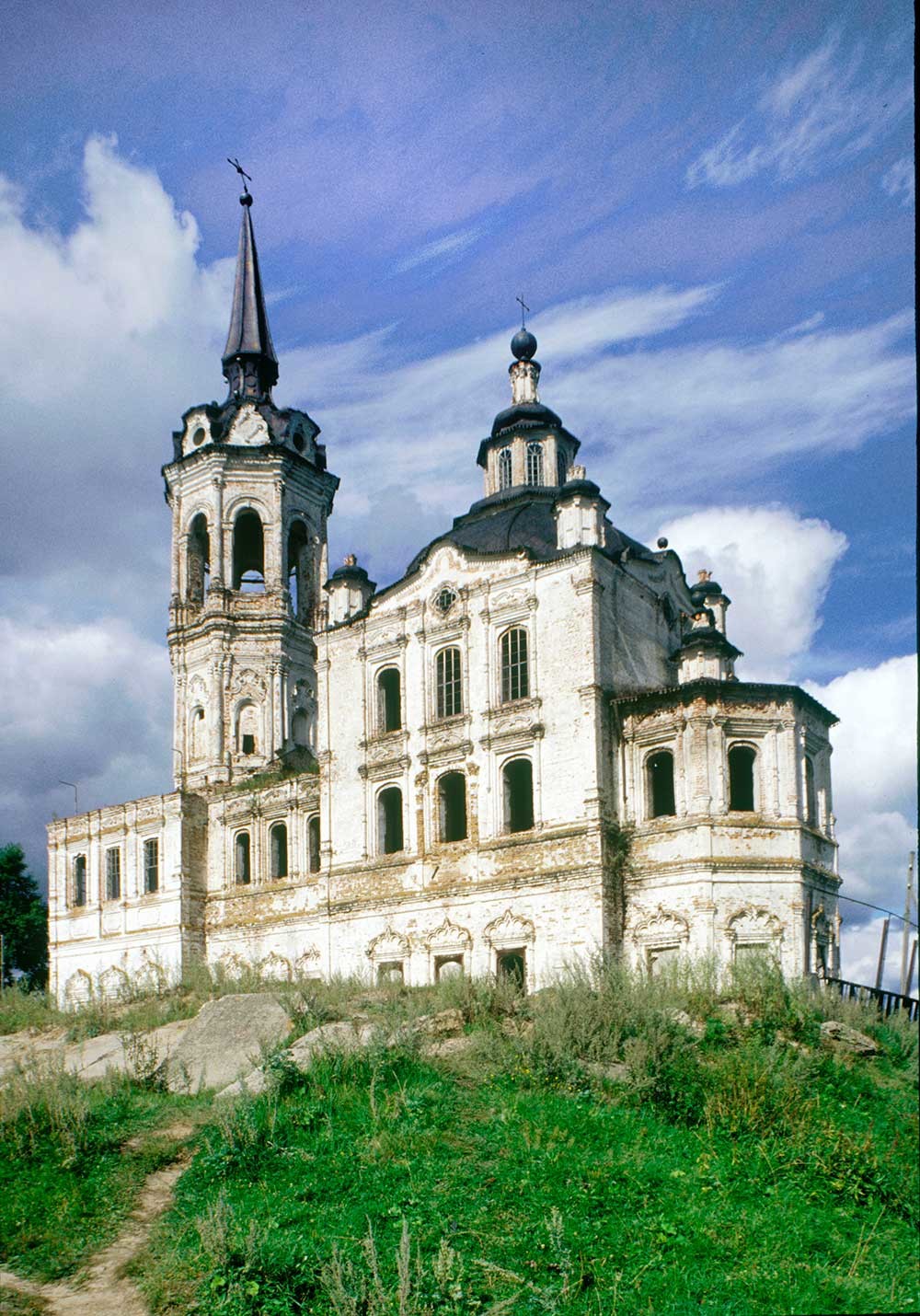
Church of Elevation of the Cross, southeast view. August 31, 1999.
William BrumfieldAfter the parish gathered funds to replace a log church, two merchants, the Medvedev brothers, donated a plot on which they had built a low artificial hill to protect their house from flooding. Construction of the church begin in 1753, and in 1761 the lower, heated church was completed, together with a vestibule attached to what had been the Medvedev house. Ten years later the upper, summer church was consecrated, yet a chronic lack of funds delayed completion of the bell tower until thirty years later, in 1784.
The Church of the Elevation of the Cross is distinguished by a harmony of height and proportion between the large main structure and the magnificent bell tower, which rises above a wide vestibule typical of 18th-century Tobolsk churches. The north facade provides further variety in the form of a long chapel built in 1790-98.
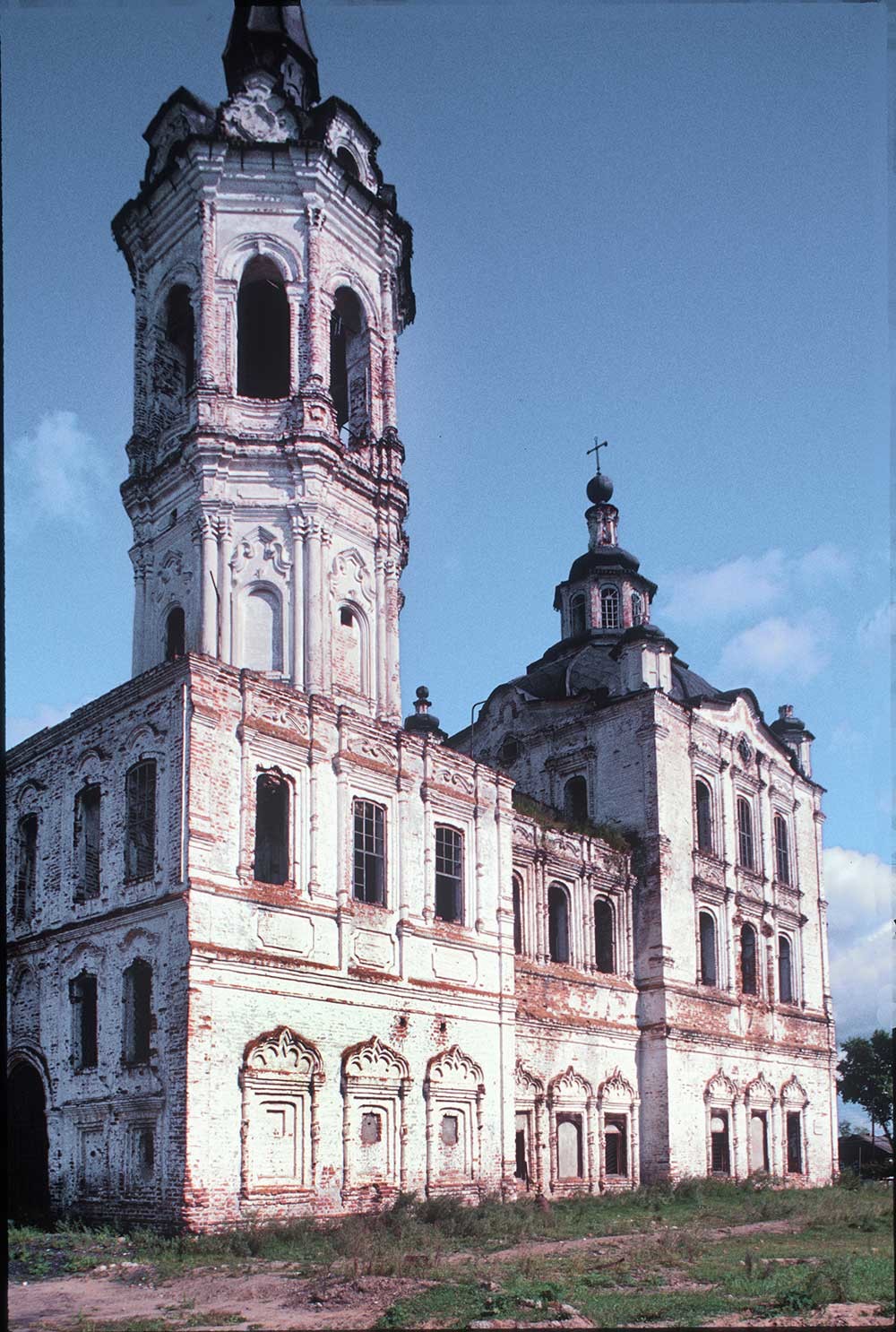
Church of Elevation of the Cross, southwest view. August 31, 1999.
William BrumfieldThe interior was among the most highly decorated of Tobolsk churches, but very little remains in this gutted structure, which has been abandoned for decades. Efforts to conserve it have been undertaken, and there is a possibility that the church, which stands on
As in other Siberian towns, church architecture in Tobolsk suffered enormous destruction during the Soviet period, Despite difficult financial circumstances, gradual restoration efforts give hope that Tobolsk will regain its status as a center of late Baroque architecture.
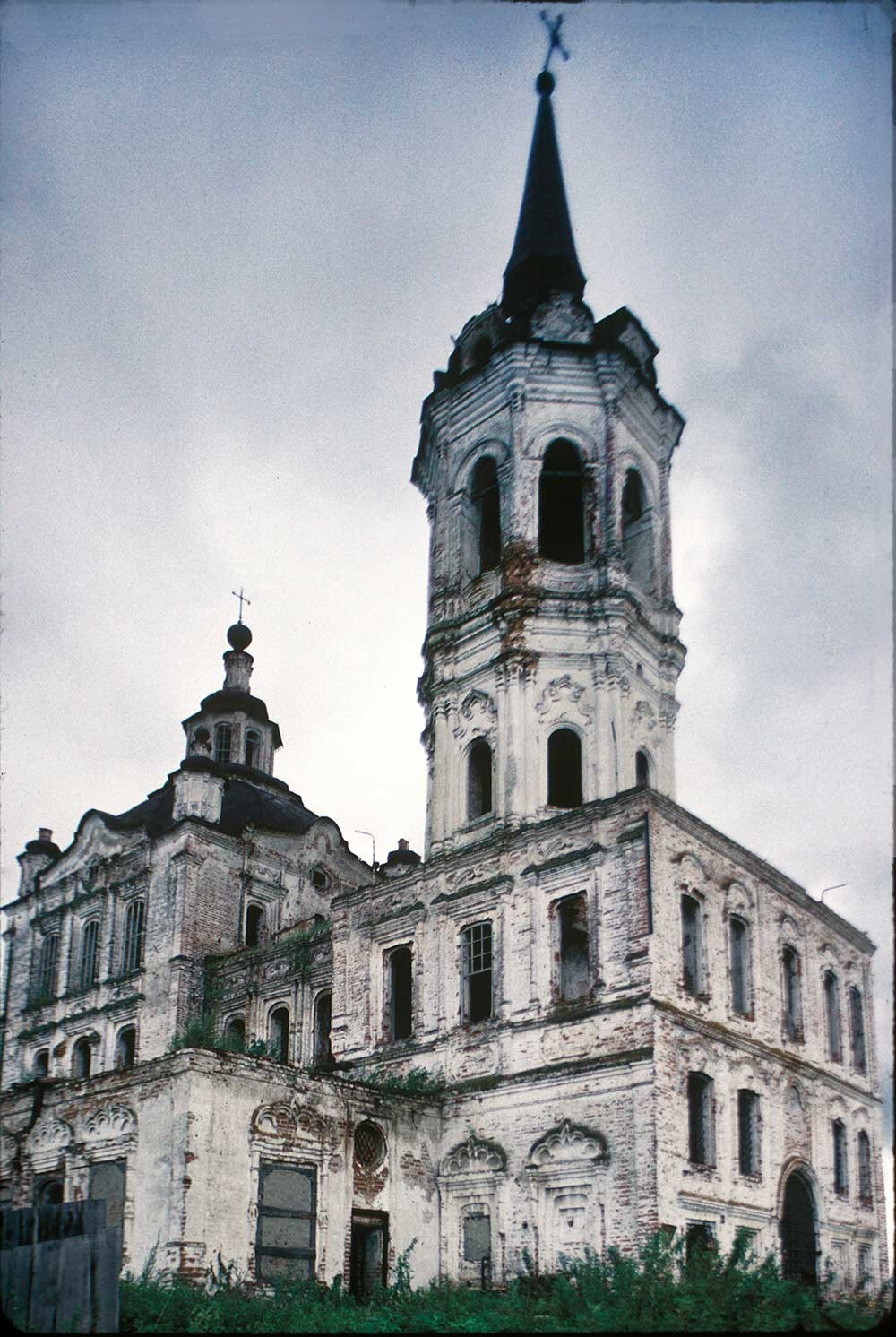
Church of Elevation of the Cross, northwest view. September 3, 1999.
William BrumfieldIn the early 20th century the Russian photographer Sergei Prokudin-Gorsky developed a complex process for color photography. Between 1903 and 1916 he traveled through the Russian Empire and took over 2,000 photographs with the process, which involved three exposures on a glass plate. In August 1918, he left Russia and ultimately resettled in France with a large part of his collection of glass negatives. After his death in Paris in 1944, his heirs sold the collection to the Library of Congress. In the early 21st century the Library digitized the Prokudin-Gorsky Collection and made it freely available to the global public. A number of Russian websites now have versions of the collection. In 1986 the architectural historian and photographer William Brumfield organized the first exhibit of Prokudin-Gorsky photographs at the Library of Congress. Over a period of work in Russia beginning in 1970, Brumfield has photographed most of the sites visited by Prokudin-Gorsky. This series of articles will juxtapose Prokudin-Gorsky’s views of architectural monuments with photographs taken by Brumfield decades later.
If using any of Russia Beyond's content, partly or in full, always provide an active hyperlink to the original material.
Subscribe
to our newsletter!
Get the week's best stories straight to your inbox